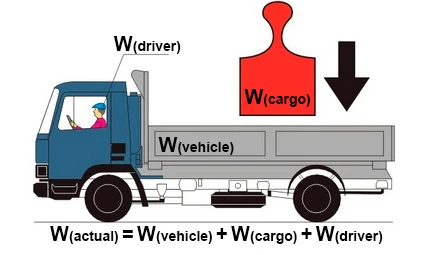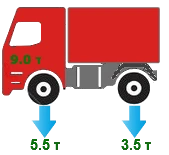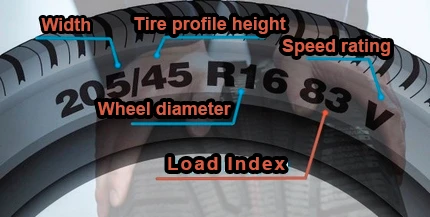Tire load index calculator
Tire load factor (or its more common name — load index) can be approximately calculated based on information from the technical passport and the characteristics provided by the manufacturer of the machine. Calculation of load tires is carried out on the basis of dividing the maximum permissible vehicle weight by 4 (the number of wheels of standard cars and off-road vehicles).
Before calculating the load index on the tire, it is necessary to determine the concepts that are available in the technical passport of the car. That’s why:

- dry weight is the mass of the car without passengers, without a spare wheel, tools and repair equipment, and also without process fluids (fuel, all oils, various cleaning and other liquids);
- curb weight — the mass of the car with process fluids (fuel, oil, etc.), as well as the driver (it is sometimes called the mass without load);
- gross weight (permitted) is the maximum mass of the loaded and loaded vehicle (with passengers, liquids, repair kit, and payload, it is also called the allowed maximum weight);
- load capacity is the mass of the payload that the vehicle can carry (passengers, baggage).
Generally, the permissible mass of the payload in the passport of the machine is not written, but indicated in the technical documentation of the manufacturer. In accordance with European norms, the average weight of a person sitting in a car is taken as 75 kg.
Remember that the allowed maximum mass (gross mass) is the sum of the mass of the machine without load (curb weight) and its carrying capacity. Therefore, the easiest way to perform the calculation of the load index of tires, if you know the allowed maximum mass of the car. To do this, its value must be divided by 4. As a result, we get the number of kilograms that the tire can withstand. It is necessary to add to this value 35… 40% for the stock. And then using the table to determine which tire load index corresponds to this value.
If the value of the maximum permissible mass of the machine is unknown to you, you can make an empirical calculation based on theoretical data. That is, add up the mass of the loaded machine and the value of its carrying capacity. After that, divide the resulting value by 4 in order to pick up tires by load index. In the above calculator, we took a margin equal to 40%, so that you had the opportunity to pick up a tire not with boundary values, but with some margin of safety. This is especially true for roads with poor coverage, of which there are many in our country.

Do not forget that many machines load on the front and rear axle is different. Therefore, it is necessary to use our empirical calculation carefully and, if possible, to use reference information and manufacturer's recommendations on which tires with which load index to use.
It is worth remembering that it is necessary to choose the tires recommended by the manufacturer, or close to these requirements. If you choose tires with a lower ratio, you risk your own safety while driving. After all, the tire is subjected to excessive loads for it. This means that at one point, it can simply explode. And if this happens at speed, the consequences can be unpredictable.
However, do not put too hard rubber. If you do such thing, you will encounter three negative factors:

- An excessive consumption of fuel. It is due to the fact that the engine needs more energy to rotate a heavier and stiffer tire.
- Stiffness. With the increase of the load index rubber becomes more rigid. Accordingly, the course of the car will also be tough and uncomfortable.
- Excessive load on the suspension. Hard tires also have a large mass. Accordingly, the suspension is additional efforts, which leads to its excessive use, and brings the failure.
Therefore, stick to the “golden mean” and install tires with a load index recommended by the manufacturer.
How to use the calculator
Follow the algorithm:
- In the “Mass of curb weight” field, enter the car mass with a full tank, process fluids, repair kit, spare wheel and driver. Usually this value is indicated on the machine’s data sheet or in the manufacturer’s documentation.
- In the field “Value of the maximum allowable weight of baggage” enter the weight value of the cargo that is supposed to be transported on the machine. In this case, note that the mass of passengers is not necessary to take into account, it has already been taken into account (at the rate of 4 passengers with a mass of 75 kg each). This information can also be found in the reference documentation for your car or on the Internet.
- Click on the “Calculate” button. In the result field, you will see the load index value for your car's tires.
Again, the calculations are empirical, and therefore we recommend that you clarify the coefficient values in the reference literature.
| Compliance table load index and the maximum weight of cars | |||
|---|---|---|---|
| Load index | Maximum weight, kg | Load index | Maximum weight, kg |
| 80 | 450 | 102 | 850 |
| 81 | 462 | 103 | 875 |
| 82 | 475 | 104 | 900 |
| 83 | 487 | 105 | 925 |
| 84 | 500 | 106 | 950 |
| 85 | 515 | 107 | 975 |
| 86 | 530 | 108 | 1000 |
| 87 | 545 | 109 | 1030 |
| 88 | 560 | 110 | 1060 |
| 89 | 580 | 111 | 1090 |
| 90 | 600 | 112 | 1120 |
| 91 | 615 | 113 | 1150 |
| 92 | 630 | 114 | 1180 |
| 93 | 650 | 115 | 1215 |
| 94 | 670 | 116 | 1250 |
| 95 | 690 | 117 | 1285 |
| 96 | 710 | 118 | 1320 |
| 97 | 730 | 119 | 1360 |
| 98 | 750 | 120 | 1400 |
| 99 | 775 | 121 | 1450 |
| 100 | 800 | 122 | 1500 |
| 101 | 825 | 123 | 1550 |
FAQ
-
What is the load index for passenger car tires?
The load index for passenger car tires is expressed as a two-digit number. On passenger car tires, you can allocate coefficients from 63 to 90. Remember that the higher the load index, the thicker, stiffer and heavier the tire. Correspondingly, there will be more noise in motion and fuel consumption will increase. The lower the index, the softer, lighter and faster the tire will wear out.
-
What is the load index for crossover tires?
The load index of crossover tires is expressed by a three-digit number, which in the marking comes immediately after the diameter at rim seat. Also the tires for crossovers often have an increased load index, and are necessarily accompanied by the additional designation — XL (extraload or reinforced). This shows that the tire has a higher strength index and that the sidewall of the tire is much stronger than a regular tire. The most common load index for crossover tires is between 90 and 105.
-
What is a 91 Load Index?
The Load Index 91 is a numerical code that indicates that the tire in question is capable of carrying a load of 615 kg at the maximum speed indicated by the tire label (the speed index is identified by a letter in the Latin alphabet, immediately following the symbol relating to load). On the tire sidewall it could look as follows: 205/55 R16 91 H.
-
What does the load index 65 mean?
The index 65 means that the tire in question has a load capacity of 290 kg. It means that, in total, a car with wheels on such tires can bear weight, together with the load, not more than 290*4, i.e. 1160 kg. In this case, the tire should have the rated internal pressure, and the speed not exceed the allowable (its value is indicated by the manufacturer with a letter index).